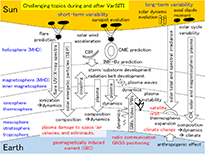** Progress in Earth and Planetary Science is the official journal of the Japan Geoscience Union, published in collaboration with its 50 society members.
Gallery View of PEPS Articles
Review
Space and planetary sciences
202103202103
A review of the SCOSTEP’s 5-year scientific program VarSITI—Variability of the Sun and Its Terrestrial Impact
Shiokawa K, Georgieva K
VarSITI, Variability of the Sun and its terrestrial impact, Sun, Heliosphere, Inner magnetosphere. Ionosphere, Thermosphere, Middle atmosphere, Climate change, Space weather
The Sun is a variable active-dynamo star, emitting radiation in all wavelengths and solar-wind plasma to the interplanetary space. The Earth is immersed in this radiation and solar wind, showing various responses in geospace and atmosphere. This Sun–Earth connection variates in time scales from milli-seconds to millennia and beyond. The solar activity, which has a ~11-year periodicity, is gradually declining in recent three solar cycles, suggesting a possibility of a grand minimum in near future. VarSITI—variability of the Sun and its terrestrial impact—was the 5-year program of the scientific committee on solar-terrestrial physics (SCOSTEP) in 2014–2018, focusing on this variability of the Sun and its consequences on the Earth. This paper reviews some background of SCOSTEP and its past programs, achievements of the 5-year VarSITI program, and remaining outstanding questions after VarSITI.
Fig2: Black: challenging scientific topics in the solar-terrestrial coupling during and after the VarSITI program. Red: their consequences on human life. Short and long-term variabilities are shown in the left and right side of the figure, respectively. CIR corotating interaction region, CME coronal mass ejection, CR cosmic ray, IMF interplanetary magnetic field, GNSS global navigation satellite system, GW gravity wave, MHD magnetohydrodynamics, PW planetary wave, UV ultraviolet







